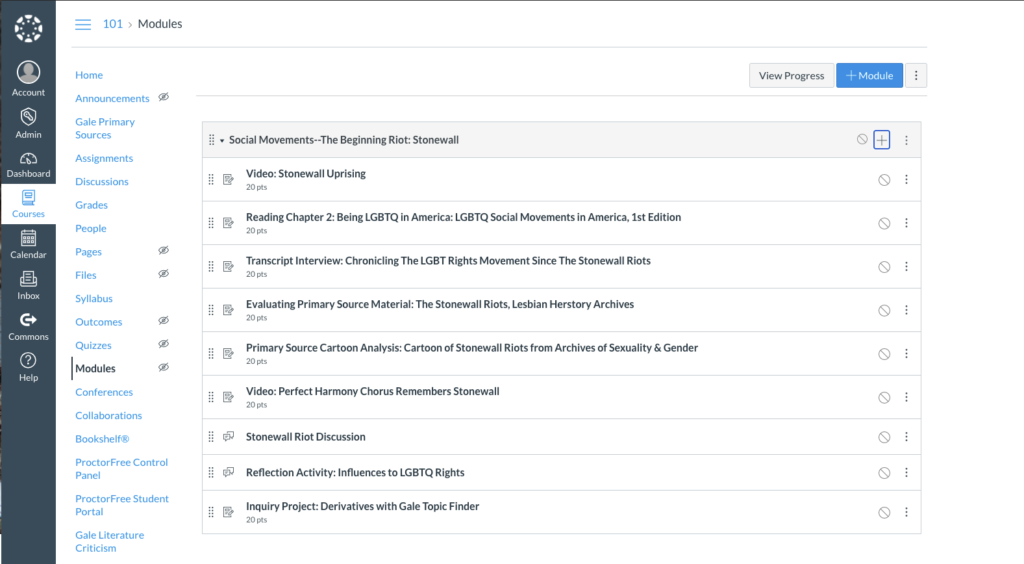Channeling Instructional Design Principles to Integrate Gale Like a Pro
| By Lindsey Gervais, Digital Learning Manager, Gale |
We are well into the online transition in course redevelopment, and we continue to face the challenges associated with developing online learning in a hurry. With a ton of content and the removal of personal interaction with students, faculty around the globe are faced with pondering what exactly the soup to nuts are of building an effective online course. A study performed by Bay View Analytics indicated that:
97 percent of institutions reported using faculty with no prior online teaching experience for some of their courses, while also indicating that 52 percent of faculty (and 61 percent of institutions) reporting they wished they had greater access to online digital materials.1
From learning management system (LMS) integration to alleviating the content gap that’s often associated with online course development to meeting accessibility standards, if you’re anxious about whether Gale’s academic resources can cut the mustard with online learning integration and providing those online digital materials faculty are looking for, there’s no need to worry. However, we also understand that the biggest challenge is how you can integrate our academic resources into your course. In the same fashion that we develop our products with learning design at the forefront, so should faculty when thinking about how to craft courses with Gale resources.
In the spirit of Gale research, we might think about course design as a series of questions you want your students to answer toward achieving learning objectives. For example, if you’re teaching Introduction to Ancient Greek History, what questions lead to milestones of success in your course? What are the learning objectives? Let’s lay out these questions to run parallel with best practices for instructional design.
What do you want your students to learn?
Online, these questions add additional structure to how you can build learning modules with your LMS. Whether it be “How did the ancient Greeks communicate with each other?” or “Why did Sigmund Freud develop his theory of dreams?”, each objective and its related questions can make up a folder or lesson that have subsequent content and activities. If you create a logical order for these modules or lessons to tell a story, students will be able to answer your learning questions and achieve objectives in a purposeful way.
How will my students achieve the learning objectives?
Having an accessibility mindset includes making sure content is digestible and functional for all learners, including students with disabilities, but also gives an opportunity for students to learn in different ways with multiple perspectives.
What resources will support student learning?
You then can determine how much content you need to fill out each module of your course, bearing in mind that a 16-week course consists of 8.5 hours of work each week. Check out this handout about time on task for online learning by Rochester Institute of Technology.
How will my students achieve the learning objectives?
Developing course activities is quite different when you transition to an online environment, especially when facilitating discussions and hands-on activities. It’s important to be mindful of how social interaction makes a difference in how your students will engage and critically think about the content you’ve crafted.
How will I create an online learning experience?
It’s important to build your course like a story, or even a video game, with it separated into modules that represent chapters or levels in a game that have opportunities not only for recall but challenging critical-thinking activities. In doing this, students can remain engaged with the content that you’ve crafted.
How do you do this? Think of each module of your course being composed of the following components that each represent milestones of your course:
- “XXX Course: Online Summer 2022”
- Module 1: Sub-Topic or Sub-Course Objectives
- Learning Objectives
- Key Learning Questions
- Content Shopping List:
- 3 15-minute chunked video lectures
- 2‒3 text documents (short form and long form)
- 2 videos and graphic or illustration
- Activity Shopping List:
- 1 discussion topic (self-response and peer-to-peer response)
- 1 weekly reflection with formative assessment question
- 1 completion of inquiry project component
Gale Ready-to-Go: You can use Gale Academic resources to completely build out your modules! Here’s an example of one meeting the criteria from above. Keep in mind that most Gale academic resources have unlimited, simultaneous user access, LMS integration, persistent links, and discovery services instilled right into the platforms.
Critical LGBTQ Movements in America: Online Summer 2022
Module 1: The Beginning Riot: Stonewall
-
- Learning Objectives: Students will evaluate the events, attitudes, and behaviors that led to the Stonewall riots, and how these attributes culminated to become part of the LGBTQ movement in the 1960s.
- Key Learning Questions: Who were the key contributors to the Stonewall riots? What were the pivotal events and developments that led to the riots? Why did the Stonewall riots occur?
- Content Shopping List: Link these sources in your LMS system. Have students use the annotation, highlighting, and note-taking features to self-regulate through their learning.
-
-
- 3 15-minute chunked video lectures
- 2‒3 text documents:
- Chapter 2: Gale eBook Being LGBTQ in America: LGBTQ Social Movements in America, 1st Edition
- “The Stonewall Riots,” Lesbian Herstory Archives, Gale Primary Sources
- “Chronicling the LGBT Rights Movement Since the Stonewall Riots,” National Public Radio, Gale Academic OneFile
- 2‒3 videos:
- Video: “Perfect Harmony Chorus Remembers Stonewall Riots,” Local Broadcast Video Content, Gale Academic OneFile
- Video: “Stonewall Uprising,” Public Broadcasting Service, Gale Academic OneFile
- Cartoon (newspaper): “Stonewall Riots,” Archives of Sexuality and Gender, Gale Primary Sources
-
Activity Shopping List:
- 1 discussion topic:
- What prompted the Stonewall riots in New York City, and how were they looked back on as a movement for LGBTQ rights?
- 1 weekly reflection:
- How did the content you reviewed about the Stonewall riots make a difference in your understanding of their monumental influences on LGBTQ rights in America?
- Inquiry project component:
- What questions do you have related to the beginning of LGBTQ in America? Use the Gale Primary Sources Topic Finder to derive keywords associated with “movements in LGBTQ in America” to develop three new research questions.
- Use the Gale Digital Scholar Lab to build a content set around one of your research questions and corresponding keywords.
Want to learn more about developing courses with Gale Academic learning resources? Stay tuned for our Gale Academic Digital Learning Handbook for everything you need to know about digital learning with Gale Academic and how to implement our content and tools into your online course.
Did we get you excited about Gale resources? Take a look at what your institution has available by using our Institution Finder and let us know how we can help launch your content into online learning.
1. Bay View Analytics, Digital Learning Pulse Survey: Immediate Priorities, accessed May 21, 2020.

Meet the Author
Lindsey Gervais is a Digital Learning Manager at Gale where she assists in the learning design and development of Gale’s Digital Scholarship Program. With a doctorate background and research recognition in the field of Cognition, Instruction, and Learning Technology, Lindsey is helping to elevate the instructional framework of Gale’s Digital Scholar Lab. She is a graduate of UCONN and taught Educational Psychology and Research Practicum for undergraduate and graduate students for 6 years. She also prides herself on her creativity, being a coffee “snob”, and endless devotion to the performing arts.


